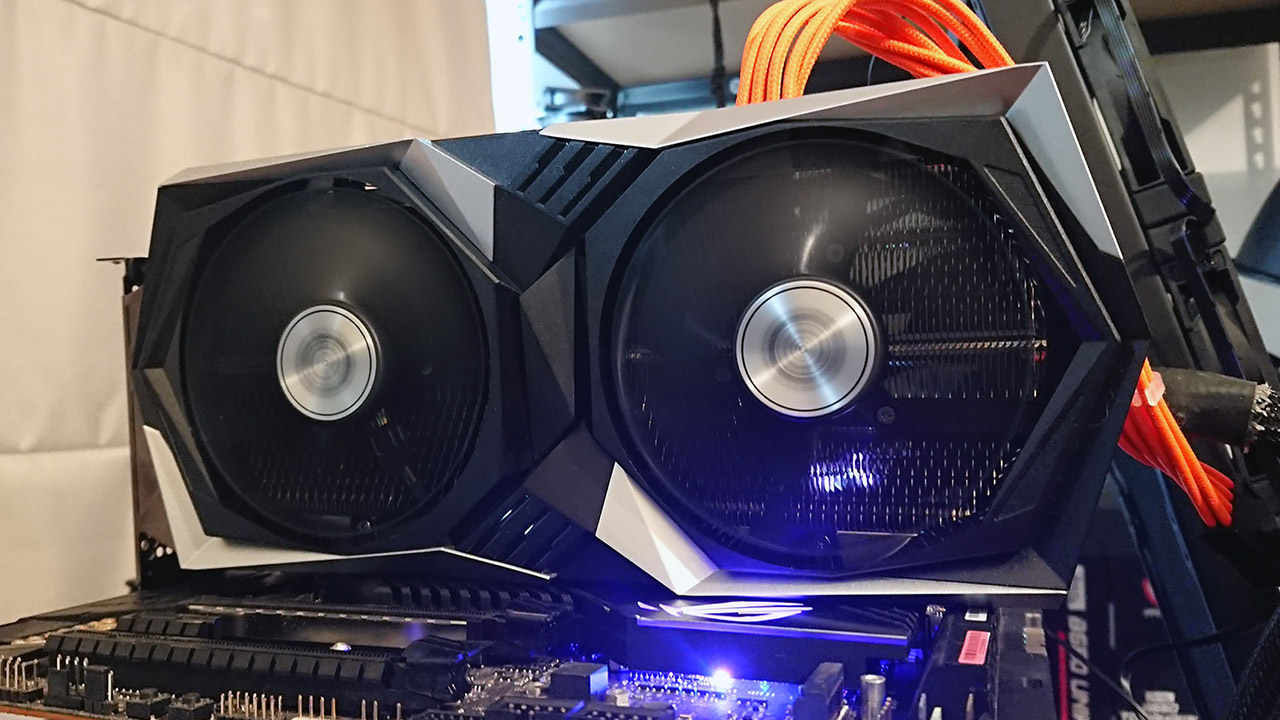Our Verdict
The MSI RX 6650 XT Gaming X is a quiet and capable 1080p card, but at the end of the day, it's a superior 6600 XT rather than something truly exciting.
For
- A great card for driving a high refresh rate 1080p screen
- Very quiet
- Excellent build quality
Against
- Small gains vs the 6600 XT
- PCIe 8x limitation
PC Gamer's got your back
It’s easy to be captivated by the latest and greatest graphics cards. While the likes of the GeForce RTX 3090 Ti or Radeon RX 6950 XT generate the headlines, it’s cards around the price of the RX 6650 XT that generate far more sales. During a time of global economic hardship, a mid-range card can sure feel like a luxury item for many gamers.
The RX 6600 XT was launched at the end of July 2021. The RX 6650 XT can be thought of as a relatively simple refresh, though AMD says the card contains some firmware and driver level tweaks. Its specifications are very similar to those of its RX 6600 XT predecessor. Both share the Navi 23 GPU, which is an 11.1 billion transistor 237 mm² die with 2,048 Stream Processors.
The RX 6650 XT doesn't improve upon the weak 128-bit memory bus of the RX 6600 XT, though its 8GB of faster 17.5Gbps GDDR6 memory delivers a memory bandwidth bump, up to 280GB/s of bandwidth. It includes 32MB of Infinity Cache which does partially offset bandwidth limitations. The RX 6650 XT also carries the same PCIe 8x limitation of the RX 6600 XT. That’s not a major concern like the 4x connection is on the RX 6500 XT, but I feel that anything other than a barebones entry level card should run on a x16 interface in 2022.
At $449 (£449, AU$719) the MSI RX 6650 XT Gaming X is still not a cheap graphics card, particularly when you compare it to a whole console. Even though the prices of graphics cards have dramatically fallen in recent weeks and months, building a high-performance gaming PC is still expensive.

GPU: AMD Navi 23
Shader Units: 2,048
Boost clock speed: 2,694MHz
Memory capacity: 8GB GDDR6
Memory speed: 17.5Gbps
Outputs: 3x DisplayPort 1.4a, 1x HDMI 2.1
Power connectors: 1x 8-pin
Price: $449 | £449| AU$719
MSI sent over an RX 6650 XT Gaming X for review. It comes with a dual fan cooler, which makes sense for the 175W TDP; MSI's larger Trio cooler would be overkill.
The Gaming X comes with a boost clock of 2,694MHz and 17.5Gbps memory. The reference RX 6600 XT comes with a 2,589MHz boost clock and 16Gbps memory so the differences between the two are certainly not dramatic.
It's not exactly a compact card but at 28cm long it's a bit friendlier for small form factor cases, though it still takes up a full three slots. The card comes with a full length backplate and includes some thermal padding to assist with keeping the memory and VRM locations a little cooler on the back of the PCB.
Overall the card feels very well built, as we generally expect from MSI's Gaming range. The MSI logo on the side is lit with RGB, for a little splash of color.



Display connectivity is fairly standard, with a single HDMI 2.1 and triple DP 1.4a ports. A single 8-pin power connector can deliver 150W, which combined with the 75W on offer from the PCIe slot, means there is up to 225W on tap to power the card.
The PCB includes an eight-phase VRM with a further two for the Samsung 18Gbps memory. It's more than sufficient for a 175W card. GPU makers have experience with cooling GPUs at double the TDP, so MSI should have learned a few lessons with VRM cooling by now!

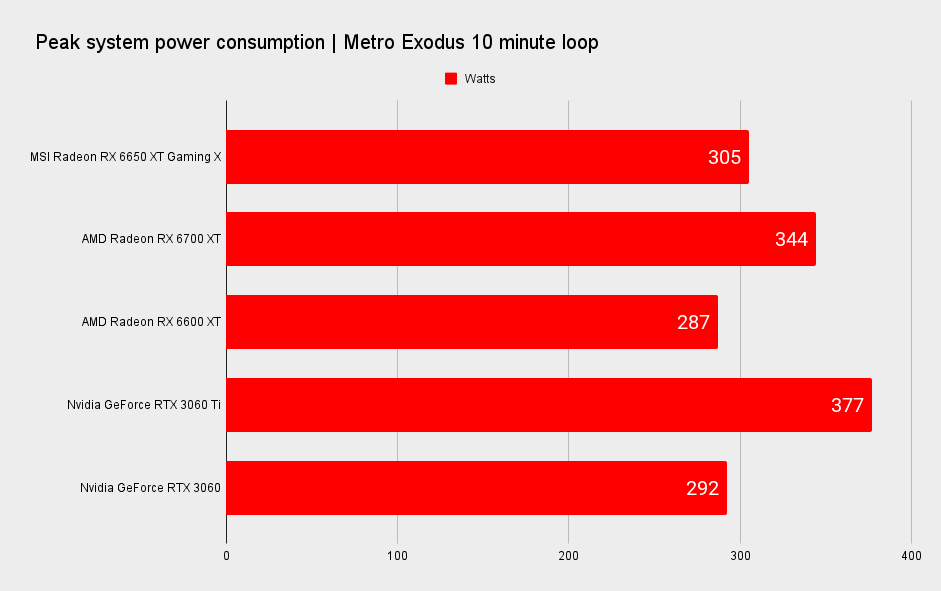
MSI could have tuned the fans to run at a slightly lower speed. In my testing, the peak temperature of the card was just 61°C
MSI's highly efficient Twin Frozr 8 dual fan cooler is well suited to the 175W TDP of the card. Under a full load, it’s barely audible and though it can be heard when running a heavy load, it's perfectly acceptable and in no way intrusive.
In fact, MSI could have tuned the fans to run at a slightly lower speed. In my testing, the peak temperature of the card was just 61°C. That's one of the lowest results I've seen from any GPU other than very low TDP entry level cards.
The MSI comes with a rated boost clock of 2,694MHz. Usually AMD cards (and Nvidia's too) can run higher than their rated clocks, subject to sufficient cooling capacity. The MSI RX 6650 XT held a long run boost clock of 2,628MHz. Given the very low load temperatures of the GPU, perhaps I expected a little higher boost clock. In the grand scheme of things that won't matter much though, if at all, in a tangible way.

When it comes to power consumption, the MSI delivered a strong result. With the price of energy shooting up through the roof, it's past time we put more emphasis on energy efficiency (sorry, the next-gen GPU shudders just hit me). Under a full load the MSI resulted in a total system load of 305W. That's just a few watts higher than an RTX 3060, while generally being faster overall.
Compared to the RX 6600XT, the RX 6650XT consumes about 15-20W more power. That's not a great result given the relatively small performance gains it delivers. My review of the MSI Radeon RX 6750 XT Gaming X Trio came to a similar conclusion. Yes, it performs better, but at the cost of a loss of power efficiency. It seems as though AMD's RX 6x50 cards are right on the limit of runaway power consumption levels. Higher clocks won't be possible without steep increases in power.
Synthetic gaming performance
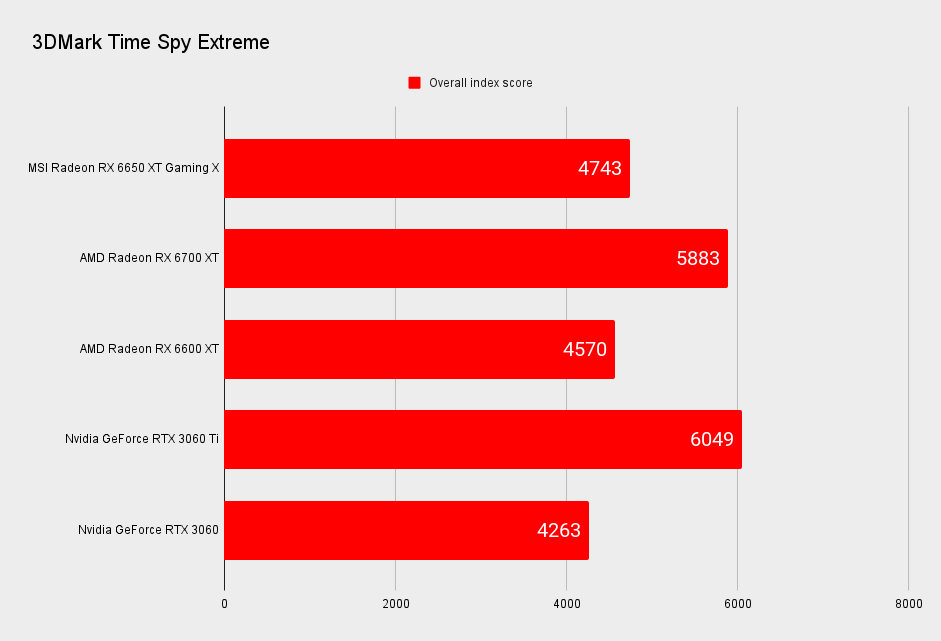

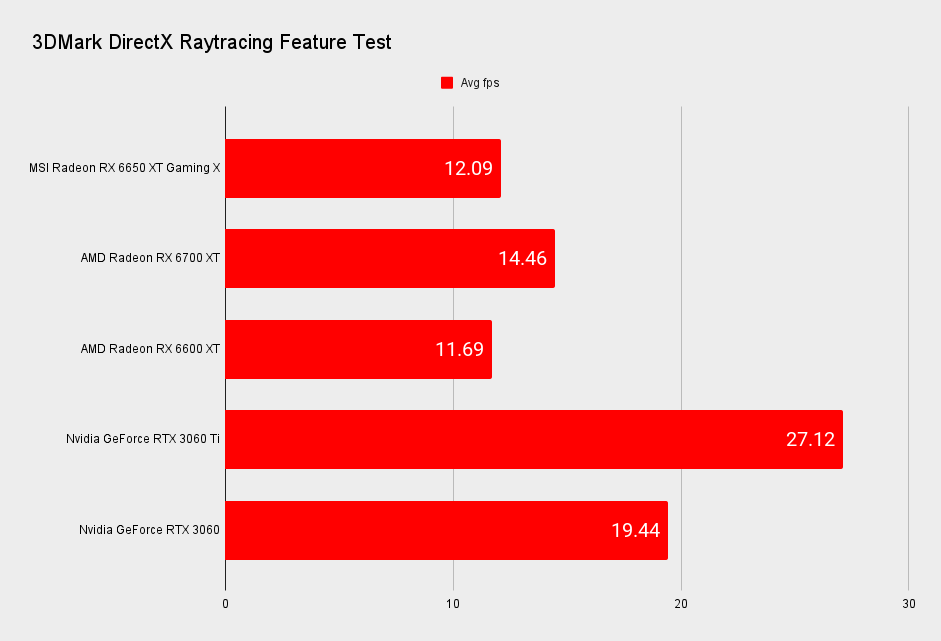
1080p Gaming Performance


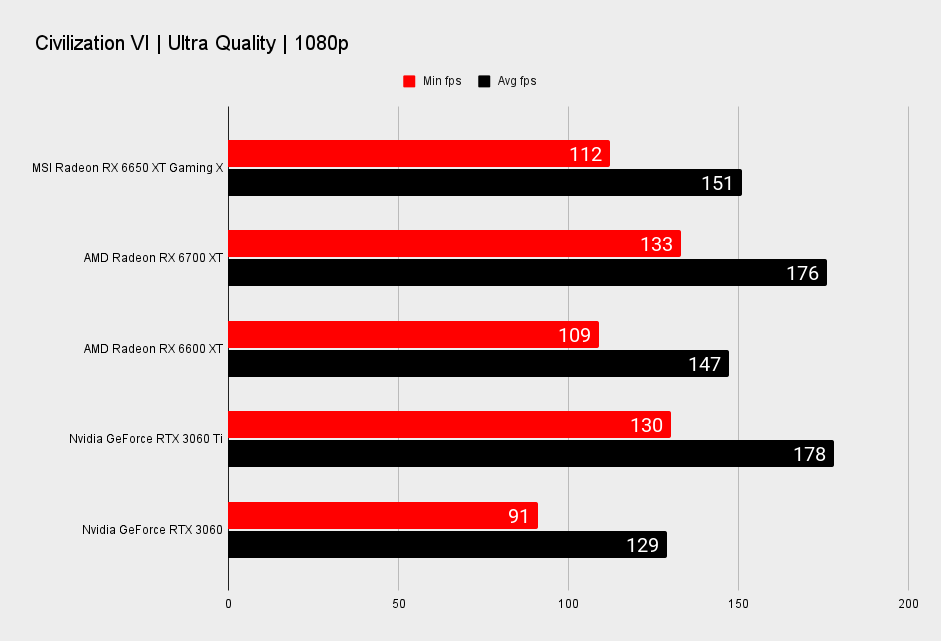
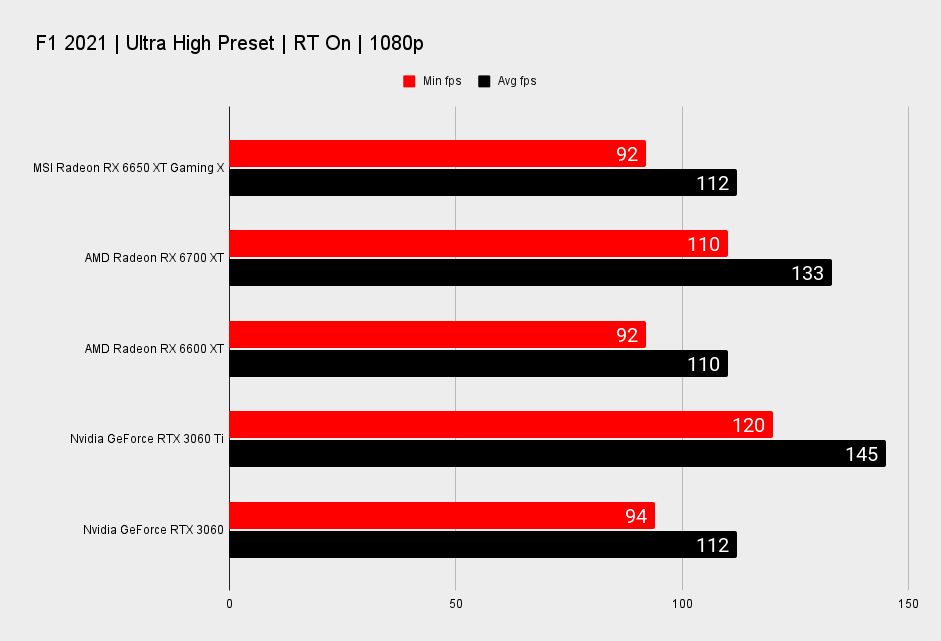

1440p Gaming Performance





4K Gaming Performance





CPU: AMD Ryzen 7 5800X
Motherboard: Asus Crosshair VIII Dark Hero
RAM: 2x 8GB T-Force Xtreem ARGB DDR4-3600
Storage: 2TB Adata S70, 500GB Samsung 980 Pro
Cooling: NZXT X73 360mm AIO
PSU: Corsair AX1000
As you can see by flicking through the charts above, The RX 6650 XT doesn’t offer market altering performance. It performs as you'd expect from an overclocked RX 6600 XT. It beats the RTX 3060 but trails the RTX 3060 Ti and the gap grows in games with ray tracing enabled.
The card is best suited for 1080p gaming. It even nears 60 fps in Metro Exodus with ray tracing enabled, which is a good result for a mid-tier RDNA 2 card, as ray tracing is not its strength. It will play games at 1440p, but at 4K you'll struggle to hit smooth frame rates.
The MSI Gaming X is a very quiet card indeed and with that under-load temperature of 61°C, which is a testament to the quality of MSI’s cooler design. The Navi 23 GPU isn't exactly a demanding one, but still it's good to see this level of performance from a dual fan design. A huge triple slot cooler would be overkill.
The RX 6650 XT feels very much an evolution of the 6600 XT. So much so that it's what the RX 6600 XT should have been originally.
When it was launched a few weeks ago, the RX 6650 XT was terribly overpriced. But in the weeks since, we've seen the crypto crash and steadily falling prices, so that now, the price of the card is more or less the same as the RX 6600 XT. Though it must be said, RX 6600 XT prices don't appear to be falling as much, which is perhaps a sign that they are not being restocked once they're sold.
The same general conclusions we reached when evaluating the stock RX6600 XT apply here. It's hard to get used to seeing anything other than an entry level card coming with a 128-bit bus and PCIe x8 limitation; it just doesn't sit right. Obviously, as memory gets faster, there's less of a need to go with a wide bus, but ATI's HD 2900 XT from 2007 had a 512-bit bus, so it's not that difficult to implement wider buses.
The RX 6650 XT will still deliver excellent performance at 1080p, however, but moving to higher resolutions at high settings will increasingly expose its limitations. The release of FSR 2.0 adds value but if you were eyeing an ever more affordable RTX 3060 or RTX 3060 Ti, the RX 6650 XT is unlikely to sway your opinion either way.
The MSI RX 6650 XT Gaming X is a quiet and capable 1080p card, but at the end of the day, it's a superior 6600 XT rather than something truly exciting.

Chris' gaming experiences go back to the mid-nineties when he conned his parents into buying an 'educational PC' that was conveniently overpowered to play Doom and Tie Fighter. He developed a love of extreme overclocking that destroyed his savings despite the cheaper hardware on offer via his job at a PC store. To afford more LN2 he began moonlighting as a reviewer for VR-Zone before jumping the fence to work for MSI Australia. Since then, he's gone back to journalism, enthusiastically reviewing the latest and greatest components for PC & Tech Authority, PC Powerplay and currently Australian Personal Computer magazine and PC Gamer. Chris still puts far too many hours into Borderlands 3, always striving to become a more efficient killer.
